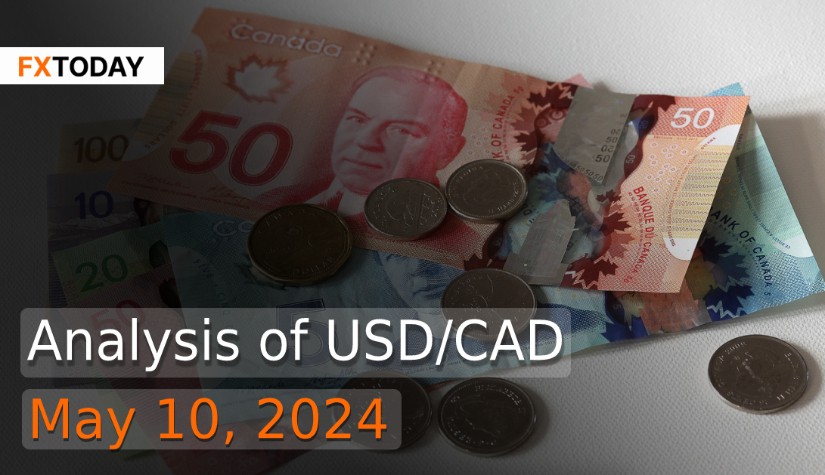Canada's Economy Shows Mixed Signals and Weakness in the U.S. Dollar
In April, Canada's services sector experienced a slower contraction, with firms reporting unexpected sales and an increase in hiring. However, rising wages contributed to inflationary pressures, as highlighted by S&P Global Canada services PMI data. The headline business activity index rose in March, its highest level since June of the previous year. Despite this improvement, the index remained below the 50 threshold for the 11th consecutive month, indicating ongoing contraction.
Similarly, retail sales in Canada declined for the second consecutive month in February, primarily due to reduced sales at gasoline stations and fuel vendors. Although the Canadian economy managed positive growth in January and was expected to remain positive in February, the pace of growth was sluggish due to pressure from near 23-year high interest rates.
In April, Canadian manufacturing activity slowed further, extending a prolonged period of contraction and marking the 12th consecutive month. Output and new orders decreased at an accelerated pace, accompanied by intensified inflationary pressures.
In the Greater Toronto area, home sales declined for the third consecutive month in April, with prices inching up due to persistent high interest rates. Although home sales surged in December and January in anticipation of interest rate cuts by the Bank of Canada, momentum dwindled in February amid slower-than-expected inflation cooling and a relatively robust economy.
Furthermore, GDP growth in February was driven by a second consecutive monthly rise in the services-producing industries, particularly transportation and warehousing. However, the goods-producing sector remained unchanged on a month-over-month basis.
However, data from Statistics Canada indicated a likely weakening of Canada's economy in the first quarter. Despite positive growth of 0.2% in February, below analysts' estimates, and expected muted growth in March, the overall economic momentum into the quarter appeared subdued. The Bank of Canada, which had raised rates to curb rising prices, hinted at possible reduction in borrowing costs in June if the recent inflation cooling trend persisted.
Bank of Canada Governor Tiff Macklem emphasized the resilience of Canada's financial system while acknowledging ongoing risks stemming from adjusting to higher interest rates and potential economic shocks. However, concerns persist, especially regarding the impact on household debt and the vulnerability of borrowers, to future economic downturns.
Macklem highlighted the potential for large and abrupt price corrections if expectations about rate paths or economic outlooks change significantly. He noted a growing focus on the timing and extent of central bank rate cuts, driving increased risk appetite, particularly in commercial real estate.
In early Asian trading on Friday, the U.S. dollar showed weakness, following a trend from overnight trading. The dollar's decline was fueled by a rise in initial claims for unemployment benefits, adding to concerns raised by last week's disappointing payrolls report. With job openings also declining to a three-year low in March, the labor market's slowdown has revived expectations of two interest rate cuts by the Federal Reserve this year. While U.S. mortgage rates fell slightly this week, they remain too high to significantly stimulate the housing market.
Looking ahead, market focus will be on upcoming data releases, including consumer prices (CPI), producer prices (PPI), and retail sales, to gauge inflation trends and their potential impact on Federal Reserve policy. This could result in the USD/CAD currency pair maintaining its current trading range, as the returns between the two countries are relatively similar.
Data for Technical Analysis (30Min) CFD USD/CAD
Resistance : 1.3690, 1.3692, 1.3695
Support : 1.3684, 1.3682, 1.3679
30Min Outlook
Source: TradingView
Buy/Long 1 If the support at the price range 1.3679 - 1.3684 is touched, but the support at 1.3684 cannot be broken, the TP may be set around 1.3691 and the SL around 1.3677, or up to the risk appetite.
Buy/Long 2 If the resistance can be broken at the price range of 1.3690 - 1.3695, TP may be set around 1.3700 and SL around 1.3682, or up to the risk appetite.
Sell/Short 1 If the resistance at the price range 1.3690 - 1.3695 is touched, but the resistance 1.3690 cannot be broken, the TP may be set around 1.3683 and the SL around 1.3697, or up to the risk appetite.
Sell/Short 2 If the support can be broken at the price range of 1.3679 - 1.3684, TP may be set around 1.3675 and SL around 1.3692, or up to the risk appetite.
Pivot Points May 10, 2024 02:43AM GMT
|
Name
|
S3
|
S2
|
S1
|
Pivot Points
|
R1
|
R2
|
R3
|
|---|---|---|---|---|---|---|---|
| Classic | 1.3675 | 1.3679 | 1.3683 | 1.3687 | 1.3691 | 1.3695 | 1.3699 |
| Fibonacci | 1.3679 | 1.3682 | 1.3684 | 1.3687 | 1.369 | 1.3692 | 1.3695 |
| Camarilla | 1.3686 | 1.3687 | 1.3687 | 1.3687 | 1.3689 | 1.3689 | 1.369 |
| Woodie's | 1.3677 | 1.368 | 1.3685 | 1.3688 | 1.3693 | 1.3696 | 1.3701 |
| DeMark's | - | - | 1.3686 | 1.3688 | 1.3694 | - | - |
Sources: Investing 1, Investing 2
















